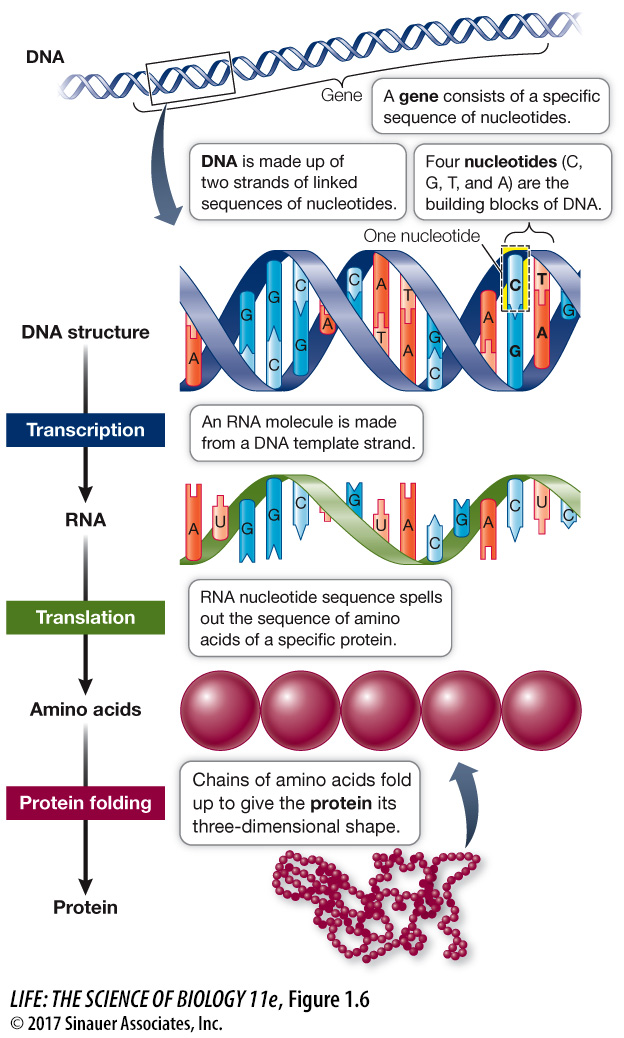Biological information is stored in a genetic code common to all organisms
Before there was a science of biology, humans recognized that offspring resemble parents, and this fact was used by plant and animal breeders to produce variants with desirable qualities. However, not until the famous plant breeding experiments of the Austrian monk Gregor Mendel in the mid-1800s was it demonstrated that inherited traits existed in discrete units (Figure 1.5). These discrete units of inheritance were termed genes in the early 1900s, giving rise to the science of genetics. An enormous body of information about traits of organisms represented by single genes was created before the chemical structure of a gene was known, and hence before the nature of the information that is passed from parent to offspring was known. That mystery was solved in the mid-1900s with the discovery that the molecule deoxyribonucleic acid, DNA, is the genetic information that specifies what an organism will look like and how it will function. This “blueprint” for the existence of each individual organism is contained in the sum total of all the DNA molecules contained in each of the organism’s cells—its genome. DNA molecules are long sequences of four different subunits called nucleotides. Genes are specific segments of DNA that encode the information the cell uses to build proteins. Therefore each gene is defined by a specific sequence of the four nucleotides. The genetic code spells out how sequences of nucleotides are *translated into sequences of amino acids, which are the building blocks of proteins. This translation process involves first transcribing some of the DNA information of a gene into the structure of another smaller molecule called ribonucleic acid (RNA) (Figure 1.6). RNA serves as the template for synthesis of a protein. Protein molecules govern the chemical reactions within cells and form much of an organism’s structure.

Figure 1.5 Genetics Developed as the Study of Discrete Heritable Traits Gregor Mendel discovered the basics of genetics through breeding experiments with pea plants. When he crossed tall plants with short plants, all of the offspring were tall. Then when he crossed these offspring plants, he got one short plant for every three tall plants. From these experiments Mendel concluded that there was a tall factor and a short factor. Each plant inherited one factor from each parent, and the tall factor was dominant.

Figure 1.6 DNA Is Life’s Blueprint The instructions for life are contained in the sequences of nucleotides in DNA molecules. Specific DNA nucleotide sequences compose genes. The average length of a single human gene is 16,000 nucleotides. The information in each gene provides the cell with the information it needs to manufacture molecules of a specific protein.
*connect the concepts How the structure of DNA codes for and is translated into proteins is discussed in Concept 4.1 and in more detail in Chapters 13 and 14.
By analogy with a book, the nucleotides of DNA are like the letters of an alphabet, and protein molecules are the words. Combinations of proteins that form structures and control specific biochemical processes are the sentences and paragraphs. The structures and processes that are organized into different complex systems with specific tasks (such as digestion or movement) are the chapters of the book, and the complete book is the organism. If you were to write out your own genome using four letters to represent the four nucleotides, you would write more than 3 billion letters. Using the size type you are reading now, your genome would fill about 1,000 books the size of this one. The processes of evolution are the authors and editors of all the books in the library of life.
Even though all the cells of a multicellular organism contain essentially the same genome, different cells of the organism have different functions and form different structures—contractile proteins form in muscle cells, hemoglobin in red blood cells, digestive enzymes in gut cells, and so on. We thus surmise that different types of cells in an organism express different parts of the genome. How cells control gene expression to enable a complex organism to develop and function is a major focus of current biological research.
The genome of an organism consists of thousands of genes. This entire genome must be replicated as new cells are produced. However, the replication process is not perfect, and a few errors, known as mutations, are likely to occur when the genome is replicated. Mutations occur spontaneously and can be induced by environmental factors such as chemicals and radiation. Most mutations are either harmful or have no effect, but occasionally a mutation improves the functioning of the organism under the environmental conditions it encounters.
The discovery of the structure of DNA by James Watson and Francis Crick in the middle of the twentieth century, and the subsequent elucidation of the mechanisms by which this material encodes and transmits information, transformed biology. These crucial discoveries are detailed in Parts Four and Five of this book.

